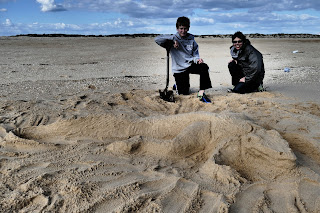

We took a few days during Semana Santa to leave the round-the clock pageantry in Sevilla (more about that later!) to enjoy the plants, birds, sand, food, and swamp of Faro and the Ria Formosa Natural Park in the Algarve in southern Portugal. It was an easy 3-h bus ride straight from Sevilla to Faro, where there was great air b-n-b, the
Animaris Ihla Deserta guided boat trip (with exceptionally good naturalist guide) out through the marasma (estuary wetland) to the Ilha Barreta (aka. Desert Island), with 10 km of amazing shell-covered beaches, spectacular vegetation, and birds everywhere. It was a spectacular 3 days of being naturalists and sand sculptors and enjoying the famous southern Portugal food.
 |
| Stumbled into a great fado concert |
|
 |
| View of the rooftops of Faro from our flat. Lots of pedestrian areas. |
 |
| The "marasma" - huge estuary - separates Faro from the ocean. |
 |
| Ilha Barreta has 2km of boardwalk and 10 km of beach |
 |
| Ammophila in its natural habitat! |
 |
| A wonderful vacation for naturalists |
 |
The famed Barreta Sand Crocodile
|
 |
| Crucianella maritima |
 |
| Linaria caesia |
 |
| Flamingos! |
 |
| Goldfinches singing everywhere |

 |
| Little egret and Spoonbill buddies. |
 |
| Razorbill swimming along side our catamaran |
 |
| White storks in the city and marasma |
 |
| Sardinian warbler on perch... |
 |
| ... and just after taking off. Wings closed! |
 |
| Piles of salt at the salt pans |
The birds of Faro, Ilha Barreta, and the salt flats of Ria Formosa we ran into are:
House Martin, Feral pigeon, Yellow legged gull, Goldfinch, Barn swallow , Swift, White stork, House sparrow, Lesser black backed gull, Little egret, Razorbill, Crested lark, Great cormorant, Grey heron, Dunlin, Sanderling, Whimbrel, Bar-tailed godwit, Ruddy turnstone, Sandwich tern, Common redshank, Yellow wagtail, Sardinian warbler, Gannet, Common shelduck, Spoonbill, Flamingo, Collared dove, Kentish plover, Ringed plover, Wheatear, Grey plover, Greenshanks
Our plant list (with a bunch of endemics and a number that are invasive in California) are: Spartina maritima, Salicornia ramosissima, Sarcocornia fruticosa, Sarcocornia perennis, Limoniastrum monopetalum, Cistanche phelypaea, Salsola vermiculata, Artemisia campestris, Helichrysum italicum, Otanthus maritimus, Malcolmia littorea, Calystegia soldanella, Paronychia argentea, Crucianella maritima, Silene nicaeensis, Anthemis maritima, Ammophila arenaria, Medicago marina, Lotus creticus, Corynephorus canescens, Cutandia maritima, Cyperus capitatus, Eryngium maritimum, Elymus farctus atlanticus, Plantago coronopus, Erodium cicutarium, Cakile maritima, Hypecoum procumbens, Leontodon taraxacoides, Linaria caesia, Linaria pedunculata, Linaria spartea, Ononis variegata, Pinus pinaster, Crithmum maritimum, Cladium mariscus, Genista hirsuta, Solanum nigrum, Genista triacanthos, Stauracanthus boivinii, Polycarpon tetraphyllum, Cistus libanotis, Arctotheca calendula, Oxalis pes-caprae, Pelargonium hortorum, Acacia longifolia, Agave americana, Carpobrotus edulis, Nerium oleander, Austrocylindropuntia subulata, Yucca aloifolia.

 We took a few days during Semana Santa to leave the round-the clock pageantry in Sevilla (more about that later!) to enjoy the plants, birds, sand, food, and swamp of Faro and the Ria Formosa Natural Park in the Algarve in southern Portugal. It was an easy 3-h bus ride straight from Sevilla to Faro, where there was great air b-n-b, the Animaris Ihla Deserta guided boat trip (with exceptionally good naturalist guide) out through the marasma (estuary wetland) to the Ilha Barreta (aka. Desert Island), with 10 km of amazing shell-covered beaches, spectacular vegetation, and birds everywhere. It was a spectacular 3 days of being naturalists and sand sculptors and enjoying the famous southern Portugal food.
We took a few days during Semana Santa to leave the round-the clock pageantry in Sevilla (more about that later!) to enjoy the plants, birds, sand, food, and swamp of Faro and the Ria Formosa Natural Park in the Algarve in southern Portugal. It was an easy 3-h bus ride straight from Sevilla to Faro, where there was great air b-n-b, the Animaris Ihla Deserta guided boat trip (with exceptionally good naturalist guide) out through the marasma (estuary wetland) to the Ilha Barreta (aka. Desert Island), with 10 km of amazing shell-covered beaches, spectacular vegetation, and birds everywhere. It was a spectacular 3 days of being naturalists and sand sculptors and enjoying the famous southern Portugal food.



















Wow!!
ReplyDelete